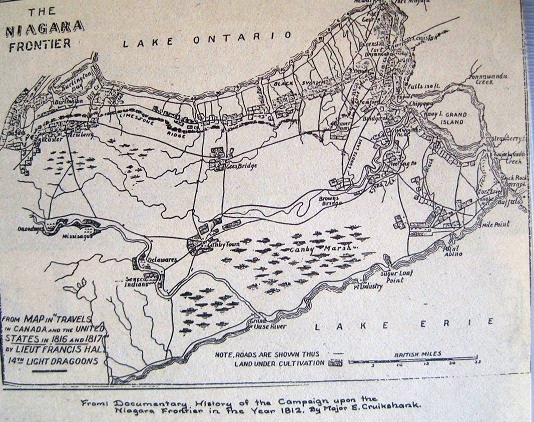PIONEER DAYS – WHERE ON EARTH IS BROWN’S BRIDGE?
By Robert J. Foley
[Regional Shopping News, 11 April 1990]
From Map in “Travels in Canada and the United States in 1816and 1817” by Lieut. Francis Hall 14th Light Dragoons.
MAP

At the foot of South Pelham Street the different worlds that make up our peninsula meet in quiet harmony. On the north east corner of Pelham Street and Colbeck Drive is a row of well-kept houses that one might see in any suburban setting in the county. West along River Road a short distance, an old silo stands as a monument to what was once a thriving homestead. Its walls are cracked and broken by vandals and the elements, yet it seems indestructible as it keeps its solitary watch. Further down a farmer unloads a hay wagon, while cattle crowd the fence on the other side of the road in anticipation. To the north on Pelham Street the road becomes gravel and passes more farms and fields, while to the south the Welland River flows by as it has done since prehistory.
Standing on the bank of the river and looking across Riverside Drive a sense of history seems to rise up to meet you. When the water levels are down a little and one looks very carefully one can see, what seem to be, dark spectres rising from the river. There appears to be five of them and with heads just above the water they whisper secrets of a by-gone era. Ghosts? In a way they are ghosts for they are the pilings for Brown’s Bridge for which a small community that thrived before the City of Welland existed was named.
The bridge was built by Lieutenant John Brown who was a veteran of the Battle of the Plains of Abraham and who settled in New Jersey in 1770 with his Scottish wife. During the American Revolution he moved north and lived first at Niagara-on-the-Lake and later settled on a grant of land on the Welland River. He immediately set about building a bridge across the Welland River which bore his name. It was constructed of wood with eight pilings and a deck of planking.
John Brown died of smallpox in 1797 and was buried in the family burying ground on his farm.
During the war of 1812 orders were given to burn the bridges over the Welland to slow the enemy. Misener’s Bridge to the east was torched but for some reason Brown’s Bridge was spared.
A bustling community grew up around the bridge on the north side. There was the Union Section Number Two School which doubled as a meeting house on the Thorold side of the town line.
Brown’s Bridge almost figured in the plans for the first Welland Canal. In 1823 Mr. Hirman Tibbet surveyed several routes one of which he reported: “Commenced at Chippawa on the 6th Inst. 10 miles from its mouth as stated by me, on Mr. John Brown’s farm, Township of Thorold, explored two routes from thence to the headwaters of the 12 Mile Creek.”
In 1824 the first library in the area, called the Welland Library Company, was set up at the school at Brown’s Bridge. Some of the books available were Adam Smith’s Wealth of Nations, Paley’s Philosophy and Washington’s Official Letters.
The first anniversary meeting of the board was held at the school house on November 26th 1825. Among the shareholders present was Mr. Alexander Brown, son of John Brown. At that meeting the constitution was discussed and it might be of some interest to see how libraries of the day operated. The bylaws concerning the borrowing of books were as follows: Books were borrowed for one month except in the case of someone living five miles from the library or greater. They could keep the book an extra week. The fine for overdue books was 7 ½ pence. Other fines were levied as follows:
1) For folding down a leaf-3.3/4 pence
2) For every spot of grease-3 ¾ pence
3) For every torn leaf -3 ¾ pence
4) Any person allowing a library book to be taken out of his house paid a fine of five shillings.
In 1858 this library was amalgamated with the Mechanics Institute in Merrittsville.
Brown’s Bridge continued to serve the Village of Welland until 1868 when, badly in need of extensive repairs, it was dismantled leaving the pilings to wait for another bridge that never came.
Go down to the foot of Pelham Street some late summer evening when it’s quiet. Sit on the bank of the river and listen to the whisper of the pilings as they tell their tales of by-gone days.
Oh, and don’t be surprised if you hear the clomp of horses hooves and the clatter of wagon wheels on the plank decking of the Brown’s Bridge.
 Subscribe..
Subscribe..
Add A Comment
You must be logged in to post a comment.